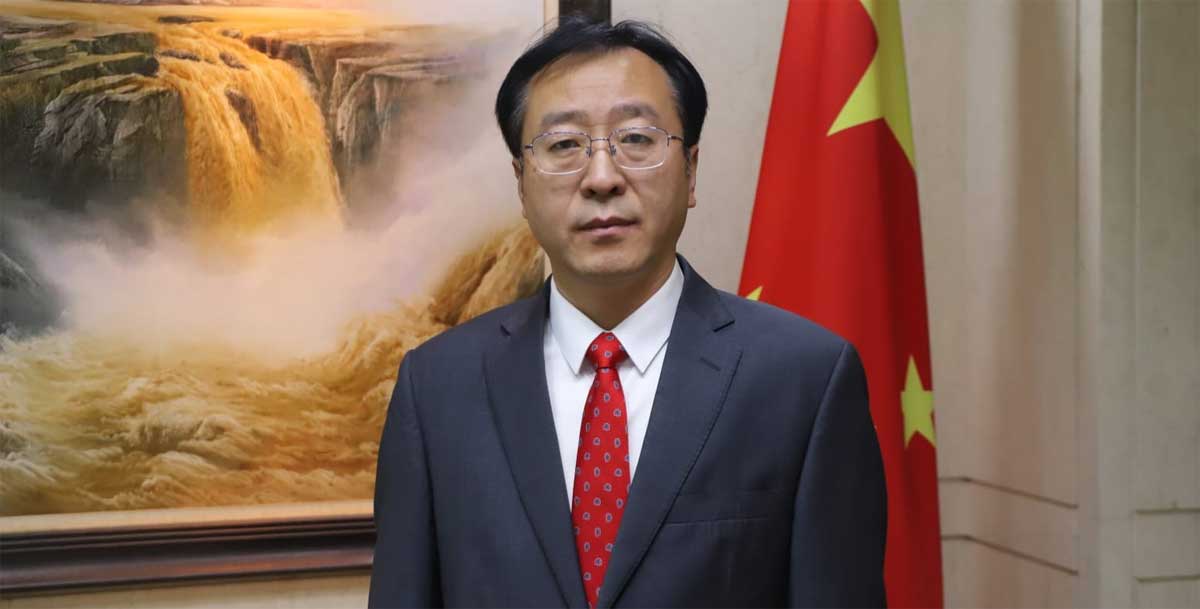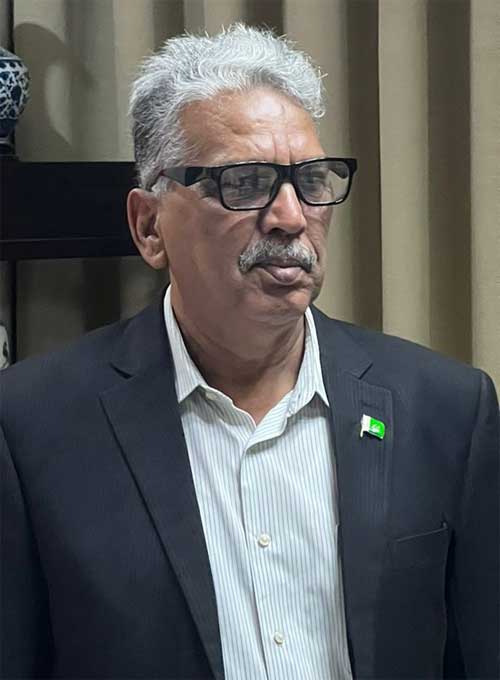H.E.Yang Yundong
August 09, 2023
Distinguished guests,Ladies and gentlemen, friends,Good afternoon! Assalam o Alaikum.It’s my great pleasure to participate in today’s event. I am also grateful for the presence of all my media friends here.Last week, the 10th anniversary of CEPC was celebrated in Islamabad. Chinese President Xi Jinping sent a congratulatory message, which pointed out that since its launch in 2013, China and Pakistan have been advancing CEPC under the principle of extensive consultation, joint contribution, and shared benefits, and have achieved several early harvests. This has added new impetus to the economic and social development of Pakistan and laid a good foundation for regional connectivity and integration. It is a vivid testament to the all-weather friendship between China and Pakistan and provides an important underpinning for building an even closer China-Pakistan community with a shared future in the new era. Since CEPC started ten years ago, altogether 36 projects have been completed or under construction, which has brought USD 25.4 billion of direct investment to Pakistan, achieving cumulative revenue of $17.55 billion, cumulative tax payments of $2.12 billion, creating 236,000 job opportunities and helping to add 8,000 megawatts of electricity, 510 kilometers of highways, and 886 kilometers of national core transmission lines. Significant progress has been achieved in the construction of Gwadar Port. The port now has 3 multi-purpose berths capable of handling 50,000-ton vessels, fully operational. Projects like the East Bay Expressway, Vocational, and Technical Training Institutions are already in operation. Gwadar New International Airport, the desalination plant, and China-Pakistan Friendship Hospital, all aided by China, are scheduled for completion in succession. The first phase of the Gwadar Free Zone has been completed, and several livelihood and agriculture technology companies have started operations. This shining “pearl” of the CPEC, which used to be a small fishing village, is accelerating its momentum towards becoming a strategic hub for logistics and industrial bases.Energy is one of the most heavily invested and productive cooperation areas under the framework of CEPC. 14 energy projects have already started commercial operation, with the total installed capacity accounting for one-fifth of Pakistan’s total capacity, and generating one-third of the electricity of the whole country at peak hours. Sahiwal, Port Qasim, and Hub coal-fired power plants were swiftly built and put into commercial operation at “China’s speed”. Various clean energy projects, such as Karot Hydropower Project, Dawood Wind Power Project, Sachal Wind Farm, the Quaid-i-Azam Solar PV Power Plant, and K2K3 nuclear power units have enriched Pakistan’s energy structure. The Thar Block I and Block II coal-fired power integration project has contributed to Pakistan’s energy self-sufficiency. The Matiari to Lahore HVDC transmission line is the first high voltage direct current transmission project in Pakistan, which transmits over 30 billion KWhour of power every year with little power loss. The implementation of various energy projects along the CPEC has illuminated millions of Pakistani households and provided reliable power support for Pakistan’s economic development. People in Pakistan no longer have to worry about frequent power shortages or power cuts.There has been tremendous progress in infrastructure development. The Sukkur-Multan motorway, with a total length of 392 KM, is the largest transport infrastructure project under CEPC, which cuts the travel time between the two cities from 11 hours to less than 4 hours. The Lahore Orange Line Metro is Pakistan’s first Metro line and the only one so far and has taken Pakistan to the Metro era. It significantly reduces the commuting time between the two ends of the line from 2.5 hours to 45 minutes. The Karakoram Highway Phase II project is connected to the “China-Pakistan Friendship Road”, enabling cargo buses to directly reach the Khunjerab Pass. Many other examples exist. The infrastructure construction along the CPEC has unlocked the potential of the regions, paving the way for development and prosperity.A remarkable achievement has been made in industrial cooperation. CPEC has encouraged an increasing number of Chinese enterprises to come to Pakistan and engage in multi-field industrial cooperation, including agriculture, manufacturing, and textiles. In the M3 Industrial City in Faisalabad, ceramic products produced with Chinese investment and technology have reached thousands of Pakistani households, greatly enhancing Pakistan’s independent capabilities in the sector of the building material industry. In many places in Punjab and Sindh provinces, Chinese hybrid rice has become a popular planting variety, significantly increasing rice yield. At the same time, cooperation in chili and canola planting is progressing steadily. The Rashakai Special Economic Zone Phase I built by Chinese companies, has been completed and begun attracting investment, while the Dhabeji Special Economic Zone broke ground in July this year. With the development of special economic zones, bilateral industrial cooperation is expected to grow even closer, laying a solid foundation for Pakistan’s industrialization process.CEPC has also helped to promote investment and trade between our two countries. According to the latest figures of the State Bank of Pakistan, in the Financial year of 2023, Pakistan received USD432.7 million of Foreign Direct Investment from China, accounting for 30.09% of the total FDI coming to Pakistan. China continues to be the largest source of FDI in Pakistan. And not long ago, for the first time, Pakistan’s seafood was transported by land along the CPEC from Karachi to Kashgar, Xinjiang. Pakistan’s exports of sugars and sugar confectionery crossed USD18 million in the first half of 2023. Also according to the General Administration of Customs of China, Pakistan Himalayan pink salt exported to China reached USD4.96 million in 2021 and 5.75 million in 2022, a year-on-year increase of 15.7%. In May this year, about two hundred entrepreneurs from China came to Karachi to participate in the 4th TEXPO, and we expect that another hundred Chinese businessmen will come again to attend the Food and Agri Expo in Karachi in the following days. At the same time, job creation is another big achievement of CEPC, which has attracted numerous local people to participate in the construction. With internship, training, and exchange programs, CEPC has become the cradle of talent in Pakistan. Over the past decade, many Pakistani people have become professionals in key managing and technical positions. Tens and thousands of young people have enhanced their skills through vocational training. Gwadar Technical and Vocational Institute trains more than 1000 technical professionals every year. In the Thar coal power plant, more than 3000 Pakistanis have been trained to be truck drivers, and among them over 50 are local women. CPEC has deepened friendly exchanges between the people of the two countries. At least 20,000 Chinese people have come to Pakistan to participate in the CPEC construction, and currently, more than 30,000 Pakistani students are studying in China. The Thar project team also took part in the building of more than 20 schools and funded many students from local families to study at Chinese universities. As the CPEC construction continues to deepen, the “ironclad” friendship between China and Pakistan will undoubtedly take a deeper root in the hearts of both peoples.The ten-year journey of the CPEC has fully demonstrated the unique nature of China-Pakistan relations. We should pay our respects to all of those who have made contributions and sacrifices to the construction of CEPC. During the construction of Sachal Wind Farm in the desert of south Sindh, the ground temperature often exceeded 40 degrees Celsius, and sands and rocks hit the Chinese engineers and workers all of a sudden. Despite all of the difficulties, the Chinese company completed the construction of the wind farm in high quality. When building the Sukkur-Multan motorway, the Chinese engineers and Pakistani workers had to perform their duties under the extreme heat of the desert. Due to the Covid protocol, one Pakistani worker was not able to return to his hometown for half a year. When talking with people, this Pakistani worker said, my Chinese brothers could not go home either, they have left their families to help us to build the road, and compare with what they are going through, it’s not such a big issue for me. What a touching story. The last thing we should forget is that 9 Chinese engineers and 3 Pakistani citizens were killed and 27 Chinese engineers were severely injured when terrorists attacked the Dasu hydropower project in July 2021. Currently, the CPEC has entered its second phase, which marks a crucial stage of high-quality development. As emphasized by President Xi Jinping, looking into the future, China is willing to work with Pakistan to adhere to high standards, sustainability, and benefiting the people, continually perfect the layout, and expand and deepen cooperation, making the CPEC an exemplary project for high-quality BRI cooperation. We have every reason to expect that the CPEC will embrace a brighter and more splendid next decade, propelling the China-Pakistan all-weather strategic cooperative partnership to new heights and making greater contributions to the peace and prosperity of both countries and the region.In a few days, it will be Pakistan Independence Day, hereby I wish all friends Happy Independence Day in advance.Pakistan Zindabad!China-Pakistan Friendship Zindabad!




